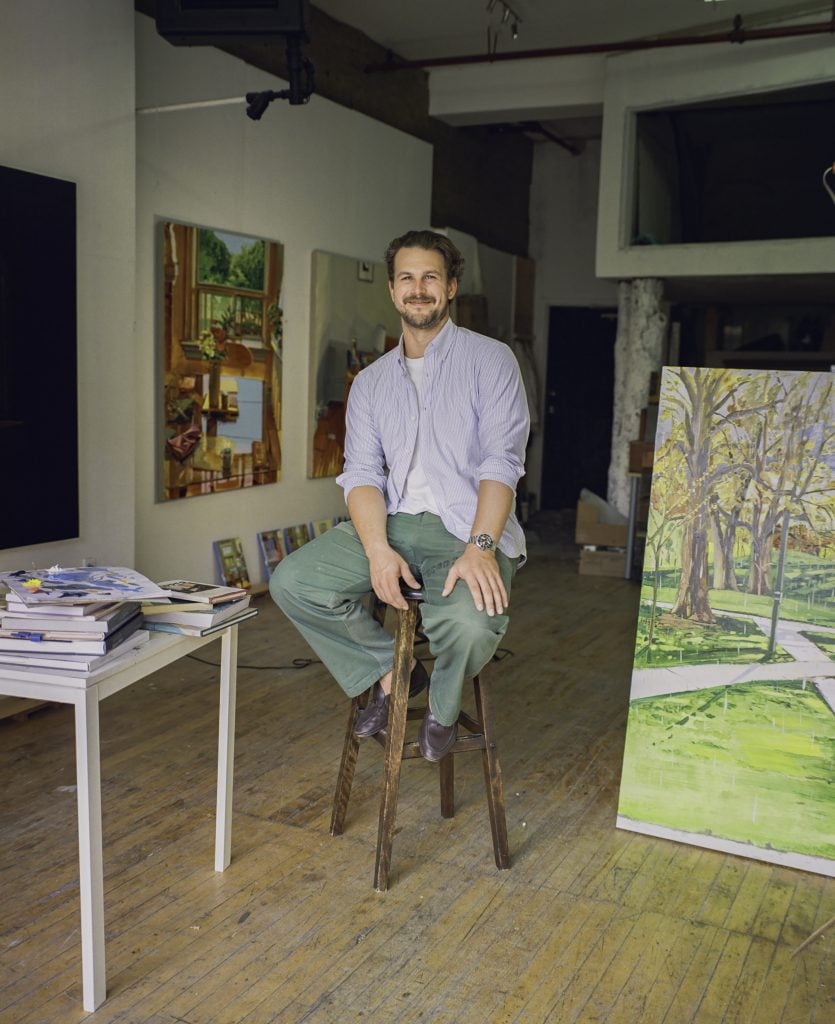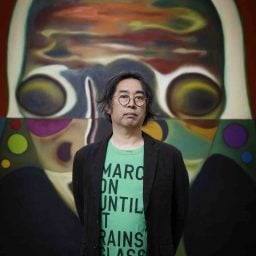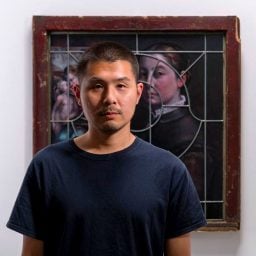At daybreak, Canadian artist Keiran Brennan Hinton (1992) angles a canvas—the biggest one he can fit—into the back of his car. He has refined this packing process, limiting himself to necessities. Into the car goes an easel, umbrellas, tarps, the six pigments he has narrowed his palette to (two blues, two reds, two yellows), along with whatever sustenance he needs for the hours ahead.
“These are the logistical things that I’ve had to figure out over the past couple of years,” he explained to me during a video call from a studio he’s rented for the summer in Toronto.
Brennan Hinton, who earned his MFA at Yale in 2016, started painting en plein air several years back and has spent the intervening years crafting a practice that is adaptable, responsive, and focused. When Brennan Hinton is working on a nocturnal scene, for instance, he might head out well into the evening hours, adding a headlight to his kit.
“I bought a gazebo recently to shield myself from rain if I’m painting in the forest behind my house. I also have a bug suit and the headlight,” he said, with a smile. “With the headlight on, all the bugs start to come to you. I go back and forth between having the light on so I can see the palette in the painting, but also not wanting to be fully swarmed. Sometimes, halfway through a painting, it’ll start to rain, so then I’ll have to incorporate that rain into the work itself. The works become panoramas of time in some way, and they try to incorporate everything that happens from the beginning to the end of the painting.”
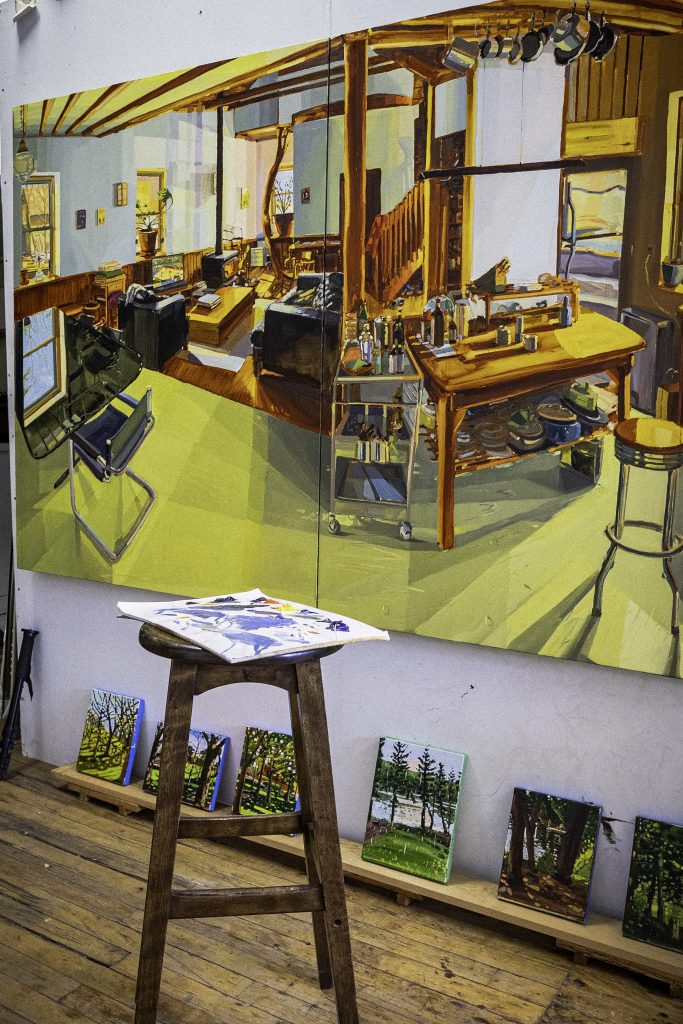
Brennan Hinton‘s studio, 2023. Courtesy of the artist.
Given that encompassing premise, Brennan Hinton will often complete a smaller painting in a single sitting, but the artist has recently scaled up some of his canvases in preparation for his upcoming exhibition, “A Break in the Clouds,” at Charles Moffett Gallery, his second solo show with the gallery, opening this September.
These large-scale works can take over a week to complete, though Brennan Hinton notes that working with oil sets its own time constraints (“When the paint dries, it lets me know it’s done,” he said). The new exhibition—a follow-up to his 2021 debut with the gallery, “Towards Sentimentality”—will include three large-scale panoramic diptychs, along with a range of medium to large works, and a series of roughly 20 small paintings. The much-anticipated exhibition comes on the heels of the artist’s sold-out booth with Moffett at Felix Art Fair in Los Angeles this February.
For Brennan Hinton, the past few years have been an experiment in exploring new ways of sharing the experience of seeing and the passage of time—the two major preoccupations of his oeuvre. Brennan Hinton, who had previously worked from photographs, developed his current approach after moving to a studio in the Bronx following graduate school (he shared the studio for a time with his friend, the artist Kenny Rivero, who also shows with Moffett). At night he would find joy in the simple solitude of painting whatever was outside his window. “The studio overlooked the city, and I would make a painting of my window almost every night, capturing the reflection of the interior, as well as seeing the outside. It was a meditative continual process that I loved,” he said.
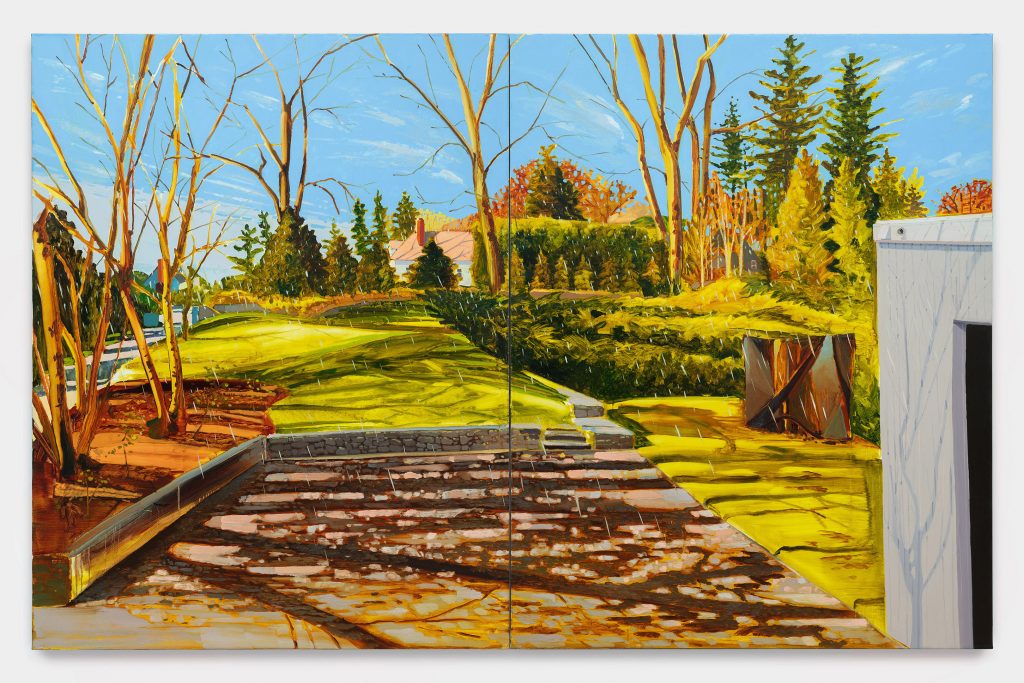
Keiran Brennan Hinton, Beecher Lane (2023). Photo by Daniel Greer. Courtesy of Charles Moffett.
These experiments in close looking would find new meaning—and appreciation—during the pandemic years. Returning to Canada, Brennan Hinton and his mother, a retired schoolteacher, bought an old schoolhouse in rural Ontario. The two quickly set about renovating the 1908-vintage single-room space, building out a bathroom, filling the space with books and blankets, and often gathering around the wood-burning stove for warmth or in the kitchen for coffee made on the stovetop. During those unending strings of days, Brennan Hinton passed the time painting this space with tenderness and nuance, capturing it over many hours, with the canvases acting as witnesses to small changes in the space, like a long exposure photograph.
At that time, Brennan Hinton had also recently started dating his now-fiancée, curator and writer Tatum Dooley, whom he would visit in her Toronto apartment. Rarely, his mother or Dooley appeared in the paintings, but more essentially, their spirits reverberated in the paintings through the objects in the space. (In “A Break in the Clouds” Dooley can be spied in miniature, far off on a dock in one painting, and Brennan Hinton’s own reflection in a mirror of another, as the only figures). These pandemic-era paintings, which were in his debut show with Charles Moffett, garnered headlines and a flurry of collector interest for the tenderness and timeliness of the intimate views, which felt familiar to those confined to their homes.
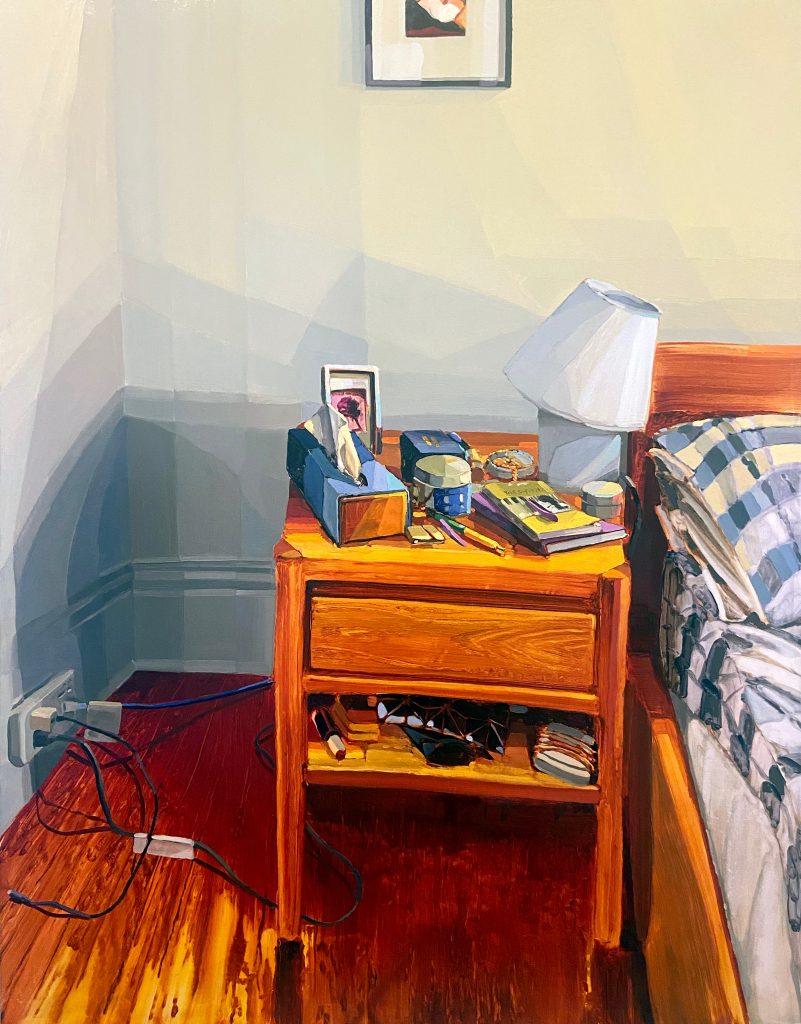
Keiran Brennan Hinton, Bedside Table (2023). Courtesy of the artist and Charles Moffett.
The spaces Brennan Hinton draws from are not always his own, however. The artist recently completed the Beecher Residency, in Litchfield, Connecticut. He spent a month living and working in a Marcel Breuer-designed home. “Mid-century modern architecture can have this initial feeling of severity or austerity, but when you get to know it, it feels incredibly lived in and natural—designed to accommodate a life,” he said. “Spending time in a place and getting to know it through making paintings is this way of like actually listening to how it’s put together and how architecture speaks to the ways that you move through the world.”
In 2018, Brennan Hinton spent a summer working at the former home of self-taught artist James Castle in a residency in Boise, Idaho. “Castle lived in the home for 50 years,” Brennan Hinton said. “He made drawings of his surroundings and traced his life through these soot and spit drawings. You could tell through the drawings where his bed was, where his cabinets were, and where his desk was. Painting in that space created an intense closeness to this person that you never knew. It’s something that’s very spiritual.” Castle passed away in the 1970s.
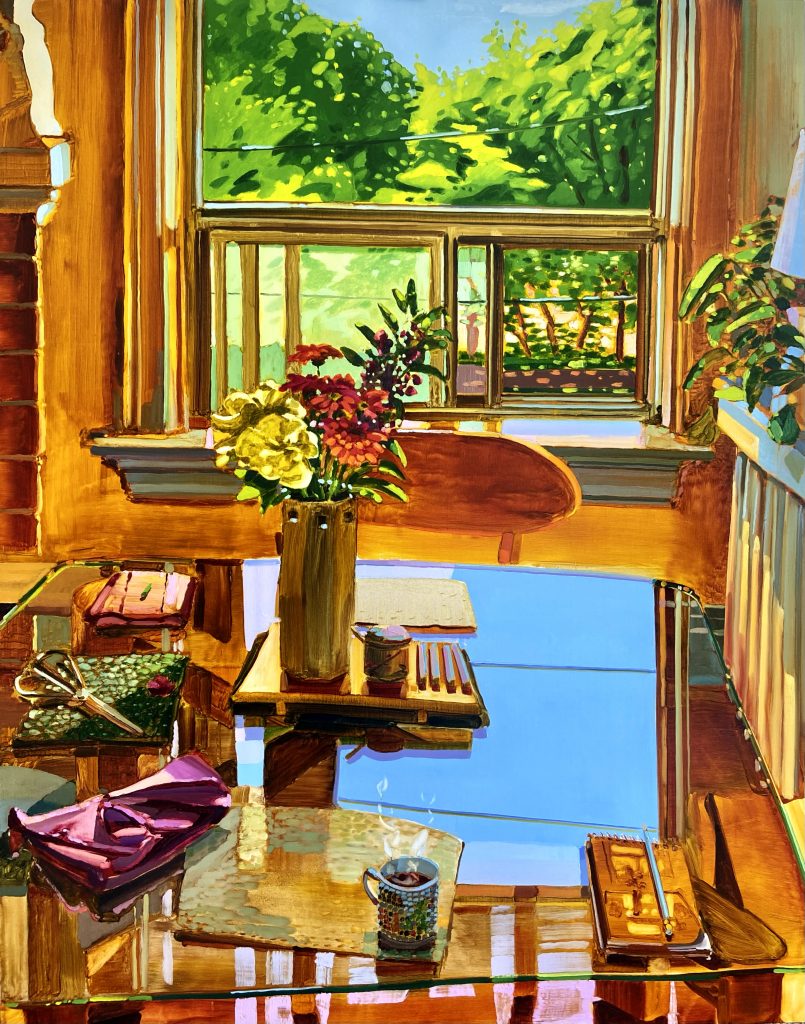
Keiran Brennan Hinton, Morning Coffee (2023).Courtesy of the artist and Charles Moffett.
Though Brennan Hinton is interested in continuing to branch out to new places, home is where his focus remains. “I’ll keep coming back to these places,” he said of the schoolhouse and the apartment he now shares with his fiancée. For him, these intimate spaces have allowed him to become acutely aware of his surroundings. “The space that you live in and spend time in every day you become really aware of as well as blind to. I find that painting allows me to see these spaces in a really fresh way,” he explained. “When you’re painting you get this intense intimacy with the people you’re living with as well as the ways you live your life. There are remnants of life in these paintings. The things that you keep on your bedside table or a steaming coffee cup. The people are just outside of the painting, but you can’t see them.”
Brennan Hinton feels that narrative readings of his paintings can weigh them down, and instead, he aspires to create paintings that allow viewers to occupy the works freely, letting them engage the space with their own eyes. With his focus on the art of looking and his interest in landscape and interiors, Brennan Hinton feels an artistic kinship to include American artists Lois Dodd and Fairfield Porter, as well as Impressionists including Bonnard and Vuillard. Brennan Hinton mentions Edward Hopper’s late-career painting Room by the Sea, from 1951. The almost uncanny work shows an empty white room, and the sea as seen from the back door of his studio on Cape Cod. “That’s a painting I could stare at forever,” Brennan Hinton said. “It feels like you’re in the painting itself.”
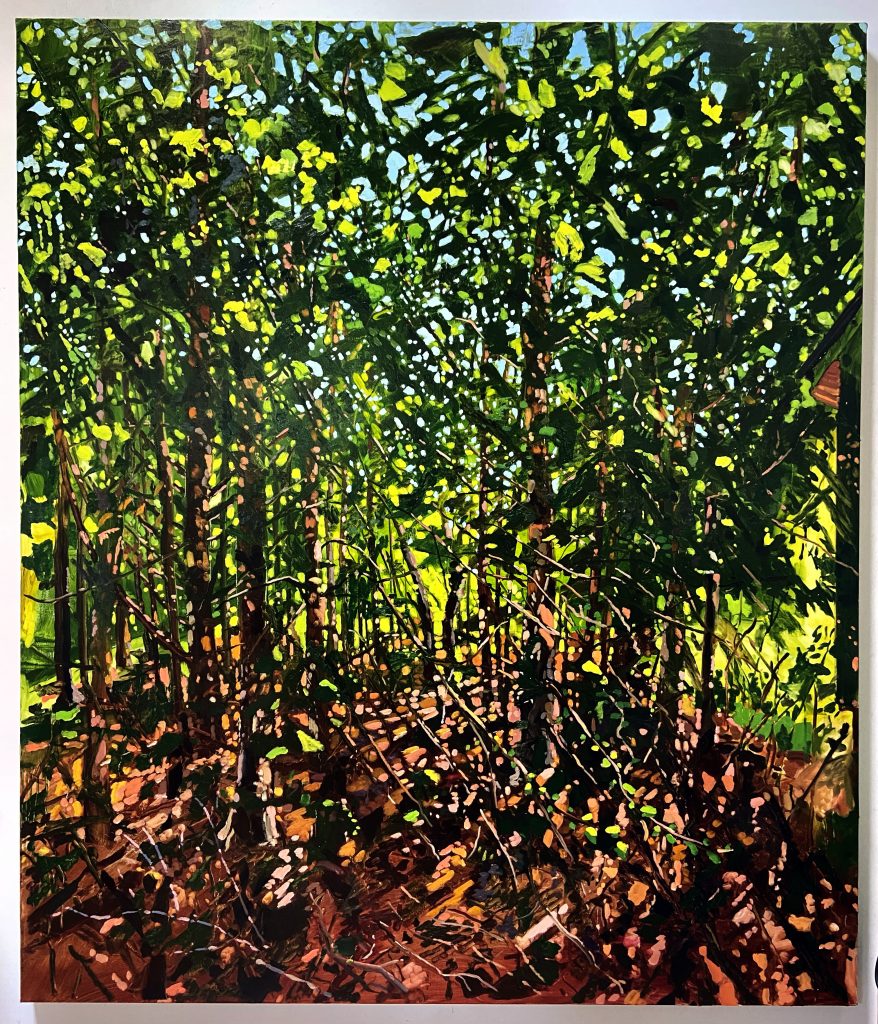
Keiran Brennan Hinton, Midsummer Forest (2023)Courtesy of the artist and Charles Moffett.
But the influence of his native Canada can’t be overlooked, either. Brennan Hinton, who played competitive football as a teenager, began painting after an injury, and recollects his teenage museum visits in Toronto, where he saw the works of the pioneering Group of Seven, Canadian landscape painters who worked from 1920 to 1933 and famously captured the country’s incredible vistas with modernist touches.
“The Group of Seven artists were painting in a similar way—going out in the world. And I’ve come full circle on them. They were my introduction to art and then I rejected them for a while,” Brennan Hinton said. “I’ve come back around to realize that they’re extremely efficient painters, in an admirable way of being able to capture a lot of information in a couple of brushstrokes and holding attention. There are a few works of the Northern Lights that are pretty remarkable.” Pausing, he thought for a minute. “I love the idea of capturing something in movement. For me, it’s a meditative process, of visiting a place over multiple seasons and recording it over and over again,” he said. “You see time do its work.”
More Trending Stories:
Archaeologists in the U.K. Are Using Ground-Penetrating Radar to Locate the 130-Year-Old Remains of a Legendary Performing Elephant
The Company Behind the Wildly Popular ‘Immersive Van Gogh’ Experience Has Filed for Bankruptcy
Drake Outs Himself as Buyer of Tupac Shakur’s Iconic Crown Ring, Sold for $1 Million at Sotheby’s
Nefarious Data Collection Masking as Public Art? An A.I. Company Has Placed Mirrored Spheres Around the World in a Massive Eye-Scanning Project
Three Ancient Roman Coins That Were Part of a Hoard Found in the U.K. Were Mysteriously Swapped With Other, More Valuable Coins
Fast-Rising Artist Jeanine Brito’s Visceral Paintings Put a ‘Dark and Grotesque’ Spin on Fairy Tales
